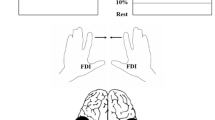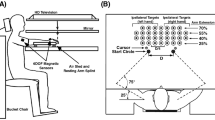Abstract
There have been inconsistencies in the literature regarding asymmetrical neural control and results of experiments using TMS techniques. Therefore, the aim of this study was to further our understanding of the neural relationships that may underlie performance asymmetry with respect to the distal muscles of the hand using a TMS stimulus–response curve technique. Twenty-four male subjects (12 right handed, 12 left handed) participated in a TMS stimulus–response (S–R) curve trial. Focal TMS was applied over the motor cortex to find the optimal position for the first dorsal interossei muscle and to determine rest threshold (RTh). Seven TMS intensities ranging from 90 to 150 % of RTh were delivered in 10 % increments. One single TMS block consisted of 16 stimuli at each intensity. Peak-to-peak amplitudes were measured and the S–R curve generated. In right-handed subjects, the mean difference in slopes between the right and left hand was −0.011 ± 0.03, while the mean difference between hands in left-handed subjects was −0.049 ± 0.08. Left-handed normalized data in right handers displayed a mean of 1.616 ± 1.019 (two-tailed t test p < 0.05). The left-handed group showed a significant change in the normalized slope as indicated by a mean of 1.693 ± 0.149 (two-tailed t test p < 0.00006). The results found in this study reinforce previous work which suggests that there is an asymmetry in neural drive that exists in both left- and right-handed individuals. However, the results show that the non-dominant motor hemisphere displays a greater amount of excitability than the dominant, which goes against the conventional dogma. This asymmetry indicates that the non-dominant hemisphere may have a higher level of excitation or a lower level of inhibition for both groups of participants.


Similar content being viewed by others
References
Amunts K, Schlaug G, Schleicher A, Steinmetz H, Dabringhaus A, Roland PE, Zilles K (1996) Asymmetry in the human motor cortex and handedness. Neuroimage 4:216–222
Cirillo J, Rogasch N, Semmler J (2010) Hemispheric differences in use-dependant corticomotor plasticity in young and old adults. Exp Brain Res 205:57–68
Civardi C, Cavalli A, Naldi P, Varrasi C, Cantello R (2000) Hemispheric asymmetries of cortico-cortical connections in human hand motor areas. Clin Neurophysiol 111:624–629
Cohen L, Gerloff C, Faiz L, Uenishi N, Classen J, Liepert J, Hallett M (1996) Directional modulation of motor cortex plasticity induced by synchronicity of motor outputs in humans. Soc Neurosci Abstr 22:1452
Guye M, Parker GJ, Symms M, Boulby P, Wheeler-Kingshott CA, Salek-Haddadi A, Barker GJ, Duncan JS (2003) Combined functional MRI and tractography to demonstrate the connectivity of the human primary motor cortex in vivo. Neuroimage 19:1349–1360
Hammond G (2002) Correlates of human handedness in primary motor cortex: a review and hypothesis. Neuroci Biobehav Rev 26:285–292
Ilic TV, Jung P, Ziemann U (2004) Subtle hemispheric asymmetry of motor cortical inhibitory tone. Clin Neurophysiol 115:330–340
Kaneko K, Kawai S, Fuchigami Y, Morita H, Ofuji A (1996) The effect of current direction induced by transcranial magnetic stimulation on the corticospinal excitability in human brain. Electroencephalogr Clin Neurophysiol 101:478–482
Krings T, Buchbinder BR, Butler WE, Chiappa KH, Jiang HJ, Cosgrove GR, Rosen BR (1997) Functional magnetic resonance imaging and transcranial magnetic stimulation: complementary approaches in the evaluation of cortical motor function. Neurology 48:1406–1416
Ridding M, Rothwell J (1997) Stimulus/response curves as a method of measuring motor cortical excitability in man. Electroencephalogr Clin Neurophysiol 105:340–344
Seibner HR, Rothwell J (2003) Transcranial magnetic stimulation: new insights into representational cortical plasticity. Exp Brain Res 148:1–16
Traversa R, Cicinelli R, Bassi A, Rossini PM, Bernardi G (1997) Mapping of motor cortical reorganization after stroke. A brain stimulation study with focal magnetic pulses. Stroke 28:110–117
Triggs W, Subramanium B, Rossi F (1999) Hand preference and transcranial magnetic stimulation asymmetry of cortical motor representation. Brain Res 835:324–329
Volkmann J, Schnitzler A, Witte OW, Freund H (1998) Handedness and asymmetry of hand representations in human motor cortex. J Neurophysiol 79:2149–2154
Wassermann EM, McShane LM, Hallett M, Cohen LG (1992) Noninvasive mapping of muscle representations in human motor cortex. Electroencephalogr Clin Neurophysiol 85:1–8
Werhahn KJ, Fong JK, Meyer BU, Priori A, Rothwell JC, Day BL, Thompson PD (1994) The effect of magnetic coil orientation on the latency of surface EMG and single motor unit responses in the first dorsal interosseous muscle. Electroencephalogr Clin Neurophysiol 93:138–146
White LE, Andrews TJ, Hulette C, Richards A, Groelle M, Paydarfar J, Purves D (1997) Structure of the human sensorimotor system. Cereb Cortex 7:18–30
Acknowledgments
This study was funded by a grant from the Natural Science and Engineering Research Council (NSERC), equipment funding from the Canada Foundation for Innovation, and an Ontario government graduate scholarship.
Author information
Authors and Affiliations
Corresponding author
Rights and permissions
About this article
Cite this article
Daligadu, J., Murphy, B., Brown, J. et al. TMS stimulus–response asymmetry in left- and right-handed individuals. Exp Brain Res 224, 411–416 (2013). https://doi.org/10.1007/s00221-012-3320-4
Received:
Accepted:
Published:
Issue Date:
DOI: https://doi.org/10.1007/s00221-012-3320-4




